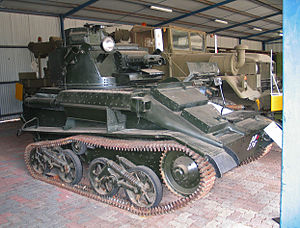Light Tank Mk VI
| Tank, Light, Mk VI | |
|---|---|

Light Tank Mk VIA-2 on display at Royal Australian Armoured Corps Tank Museum.
|
|
| Type | Light tank |
| Place of origin |
|
| Service history | |
| In service | 1936–1942 (frontline) 1948 Arab–Israeli War |
| Used by | United Kingdom Australia New Zealand Canada Egypt |
| Wars | Second World War 1948 Arab–Israeli War |
| Production history | |
| Designer | Vickers-Armstrongs |
| Manufacturer | Vickers-Armstrongs |
| Produced | 1936–1940 |
| Number built | 1,682 |
| Variants | Mk VIA, Mk VIB, Mk VIC |
| Specifications | |
| Weight | 4.85 long tons (4.93 t) later 5.2 long tons (5.3 t) |
| Length | 13 feet (4.0 m) |
| Width | 6 ft 10 in (2.08 m) |
| Height | 7 ft 3 in (2.26 m) |
| Crew | 3 (commander, gunner, driver) |
|
|
|
| Armour | 4 – 14 mm |
|
Main
armament |
.50 in Vickers machine gun (Mk VIC – 15 mm Besa machine gun) |
|
Secondary
armament |
.303 in Vickers machine gun (Mk VIC – 7.92 mm Besa machine gun) |
| Engine |
Meadows 6-cylinder petrol 88 hp |
| Power/weight | 16.9 hp/ton (Mark VIB and VIC) |
| Transmission | Wilson pre-selector gearbox |
| Suspension | Horstmann inclined springs |
| Ground clearance | 10 inches |
| Fuel capacity | 30 imperial gallons (140 l; 36 US gal) |
|
Operational
range |
130 miles (210 km) |
| Speed | 35 miles per hour (56 km/h) (25 miles per hour (40 km/h) off road) |
The Tank, Light, Mk VI was a British light tank, produced by Vickers-Armstrongs in the late 1930s, which saw service during World War II.
The Tank, Light, Mk VI was the sixth in the line of light tanks built by Vickers-Armstrongs for the British Army during the interwar period. The company had achieved a degree of standardization with their previous five models, and the Mark VI was identical in all but a few respects. The turret, which had been expanded in the Mk V to allow a three-man crew to operate the tank, was further expanded to give room in its rear for a wireless set. The weight of the tank was increased to 10,800 pounds (4,900 kg), which although heavier than previous models actually improved its handling characteristics, and an 88 horsepower (66 kW) engine was added to the model to increase its maximum speed to 35 miles per hour (56 km/h). It had the Horstmann coil-spring suspension system, which was found to be durable and reliable, although the fact that the tank was short in relation to its width and that it pitched violently on rough ground made accurate gunnery whilst moving exceptionally difficult. The Mk VI possessed a crew of three consisting of a driver, gunner and commander, who also doubled as the radio operator, between 4 millimetres (0.16 in) and 14 millimetres (0.55 in) of armour, which could resist rifle and machine gun bullets, and its armament consisted of one water-cooled .303 inch and one .50 inch Vickers machine gun.
Production of the Mk VI began in 1936 and ended in 1940 with 1,682 Mark VI tanks having been built. Many of those produced were actually variants designed to solve problems found with the original design. The Mk VIA had a return roller removed from the top of the leading bogey and attached to the hull sides instead, and also possessed a faceted cupola. The Mk VIB was mechanically identical to the Mk VIA but with a few minor differences to make production simpler, including a one-piece armoured louvre over the radiator instead of a two-piece louvre, and a plain circular cupola instead of the faceted type. The Mk VIC, which was the last in the MK VI series, had the commander's cupola removed and had wider bogies and three carburettors to improve engine performance; it was also more powerfully armed than the other models, replacing the .303 and .50 Vickers machine guns with co-axial 15-millimetre (0.59 in) and 7.92-millimetre (0.312 in) Besa machine guns. A small number of specialized variations were also built based on the Mk VI chassis. The Tank, Light, AA Mk I was built in the aftermath of the Battle of France and was intended to act as a counter-measure against attacks by German aircraft. It featured a power-operated turret fitted with four 7.92 mm Besa machine guns; a Mk II was produced which was mechanically similar but had improvements, such as better quality sights for the machine guns and a larger turret for easier access. A variant on the Mk VIB was produced for service with the British Indian Army, in which the commander's cupola was removed and replaced with a hatch in the turret roof.
...
Wikipedia
